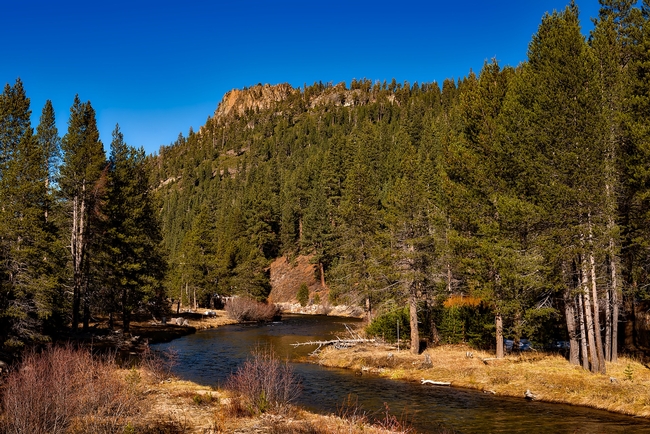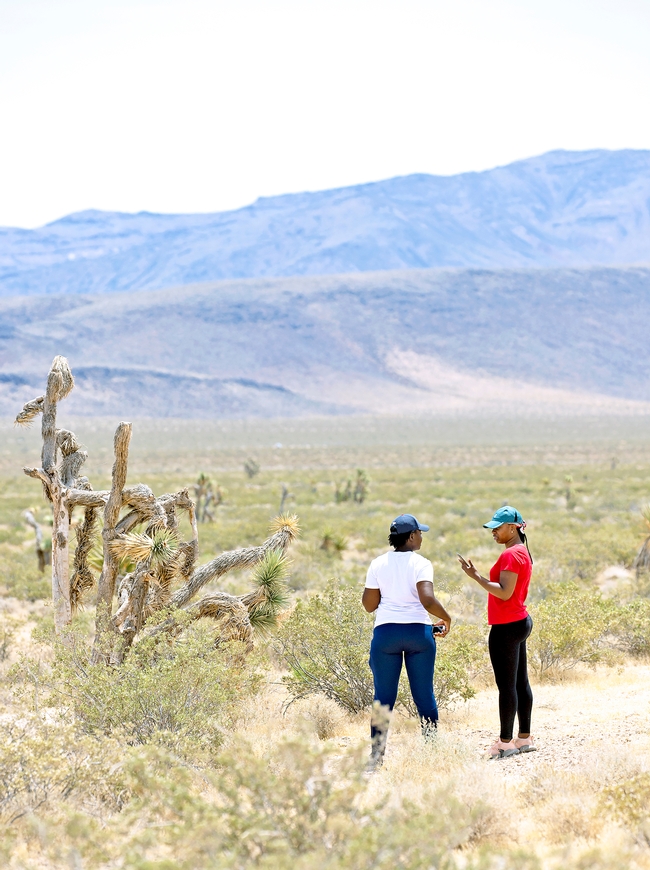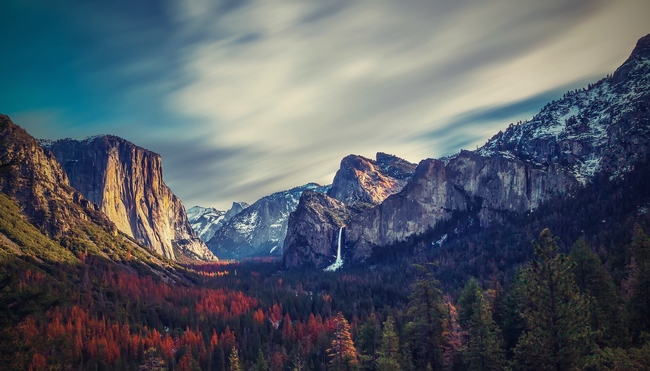
Posts Tagged: bird
Breathtaking Bluebonnets and Butterflies
If you've never been to the 284-acre Lady Bird Johnson Wildflower Center at the...
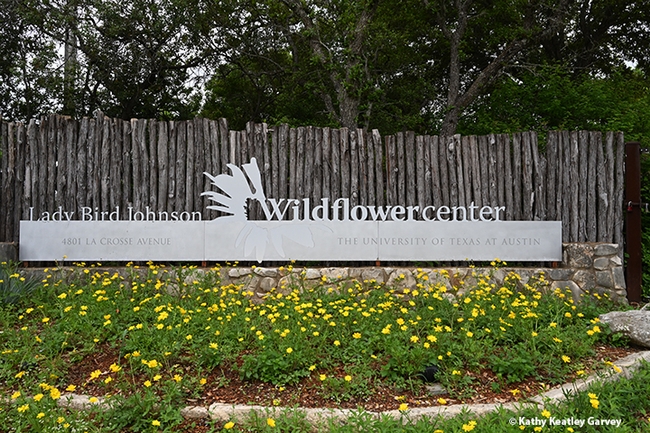
Signage at the 284-acre Lady Bird Johnson Wildflower Center at the University of Texas, Austin, welcomes visitors. (Photo by Kathy Keatley Garvey)
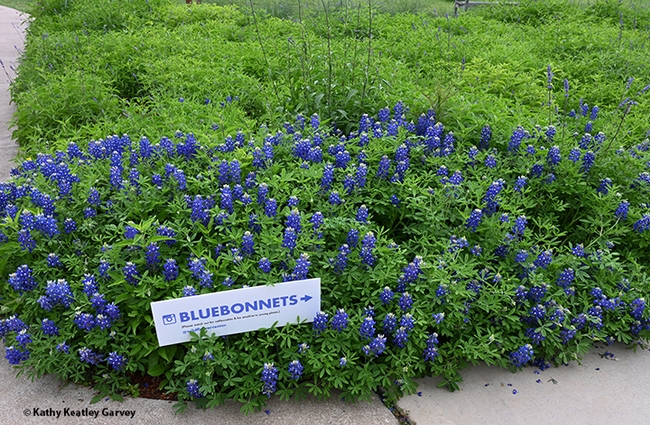
A bluebonnet sign warns visitors of rattlesnakes. (Photo by Kathy Keatley Garvey)
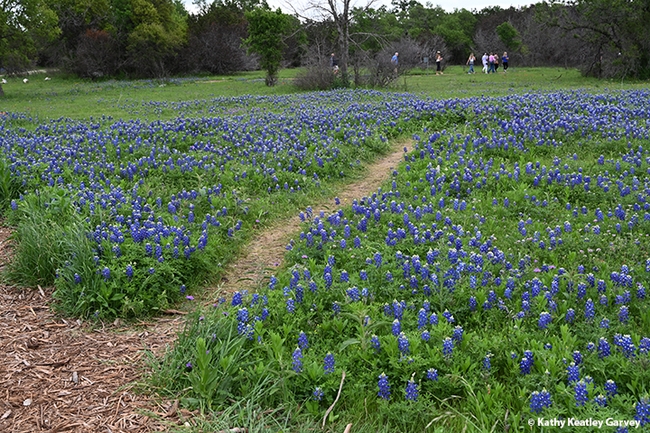
Visitors are to stay on the path at the Lady Bird Johnson Wildlower Center. This image was taken on Easter Sunday. (Photo by Kathy Keatley Garvey)
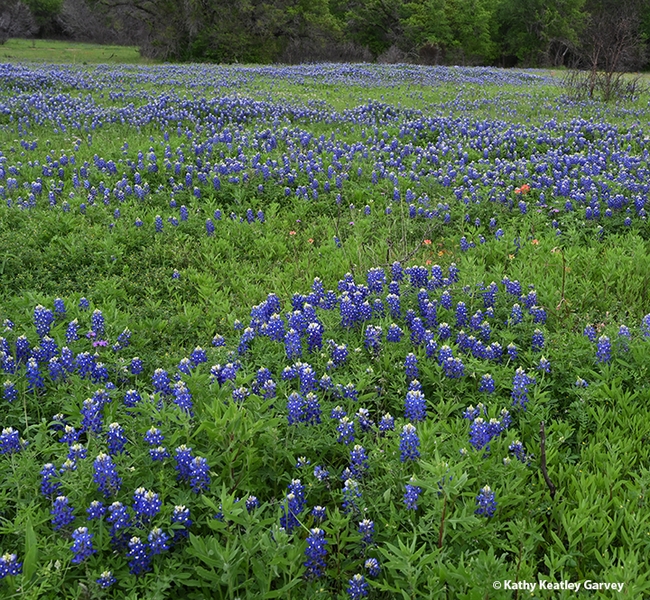
The bluebonnets were spectacular on Easter Sunday. (Photo by Kathy Keatley Garvey)
UCCE promotes nature as a way to improve wellness
Many Californians' well-being has suffered after months of sheltering at home amid the coronavirus pandemic. An antidote for the boredom, loneliness and uncertainty is spending some time outdoors, according to UC Cooperative Extension experts. It's a practice that renews the spirit and can easily be done while following social distance and face covering requirements.
A few 4-H youth camp programs have gone virtual, but for most 4-H members the annual trek to summer camp has been cancelled. 4-H Youth Development advisor Marianne Bird is encouraging 4-H members and families to get outside on their own.
“Being outdoors is something healthy to do,” Bird said. “Public parks are being used more and in safe ways. I see groups of people social distancing and eating lunch in the shade, bringing a lawn chair and sitting outside. Two weeks ago, I saw someone playing violin next to the American River bike trail.”
This month, Bird is teaming up with two colleagues for socially distanced camping for a few nights in the Sierra. They'll drive separately and sleep in separate tents, while they hike trails, swim in a lake and enjoy the night sky at least 6 feet apart. But even in her hometown of East Sacramento, Bird said she finds nature that promotes her well-being.
“I ride my bike on the American River trail. I see wild turkeys, jackrabbits and coveys of quail,” Bird said. “Walking in my neighborhood, I found a woodpecker home in a tree. Nature is everywhere, even in our urban environment.
UC Cooperative Extension assistant vice provost Katherine Soule conducts research on the benefits of outdoor activities. She and colleagues surveyed visitors at the Leaning Pine Arboretum in San Luis Obispo. Respondents said the garden visits wove together opportunities for learning, stress relief and relaxation, which enhanced the visitors' enjoyment of life, their self-awareness and their sense of belonging.
One participant mused, visiting a botanical garden “feels open, not cramped. In my mind, that's part of being outdoors. Outside you want to be free, open. I enjoy it.”
UC Cooperative Extension's California Naturalist program is including research-based information on the health benefits of nature exposure in its soon-to-be launched UC Climate Stewards program, according to Sarah-Mae Nelson, UC Climate Stewards Initiative academic coordinator. The pilot training program that begins Aug. 24 teaches volunteers to educate the community on climate change mitigation, adaptation and resiliency,
Trainees will learn about research conducted around the world that has documented the restorative capacity of nature, Nelson said. For example, a 2010 research project in Japan found that spending time in forests lowered blood pressure, cut levels of cortisol – commonly known as the “stress hormone” – and reduced pulse rate, among other beneficial health impacts.
Benefits were derived from visiting zoos and aquariums, according to a 2010 study in Japan and a 2015 study in England. Just working in the presence of potted plants reduced stress and increased productivity, found scientists in Australia. Researchers in the Netherlands discovered that simply gazing at photos with trees and parks can prevent and relieve stress.
“What's really encouraging to me as an educator and communicator is the evidence for zoos, aquariums and images as proxies,” Nelson said. “Right now, with the situation with COVID-19, people can't access nature as readily. And, looking at the diversity, equity and inclusion aspect, some people don't have the financial or social capability to enter into natural spaces.”
Another study that is shaping the UC Climate Stewards curriculum, conducted in England and published last year, indicated that spending at least 120 minutes in nature provides a significant positive impact on mental and physical wellness.
“After 120 minutes, the participants felt less depressed and had an increased ability to deal with stressful situations,” Nelson said.
For that reason, the 120-minute threshold number for nature exposure will be part of the UC Climate Stewards' approach to reduce the effects of traumatic stressful experiences, like those brought on by climate change concerns.
The Butterfly and the Bird
A monarch butterfly fluttered into our pollinator garden in Vacaville yesterday and sipped nectar...
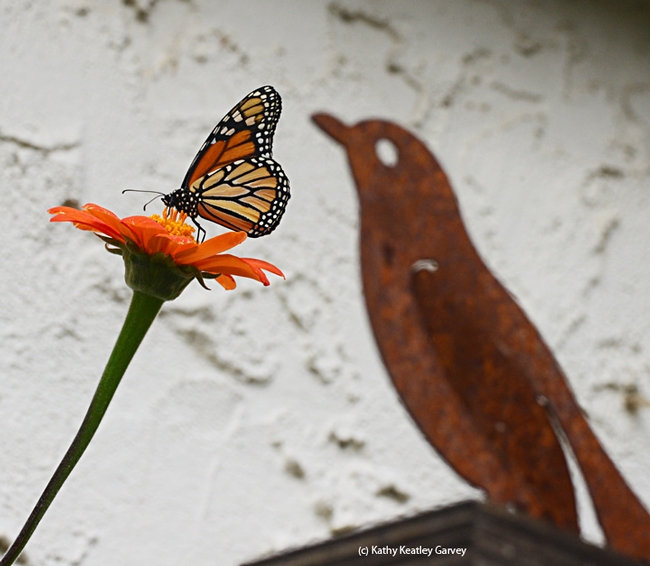
A monarch butterfly sips nectar from a Mexican sunflower (Tithonia) in front of a bird, decorative art. (Photo by Kathy Keatley Garvey)
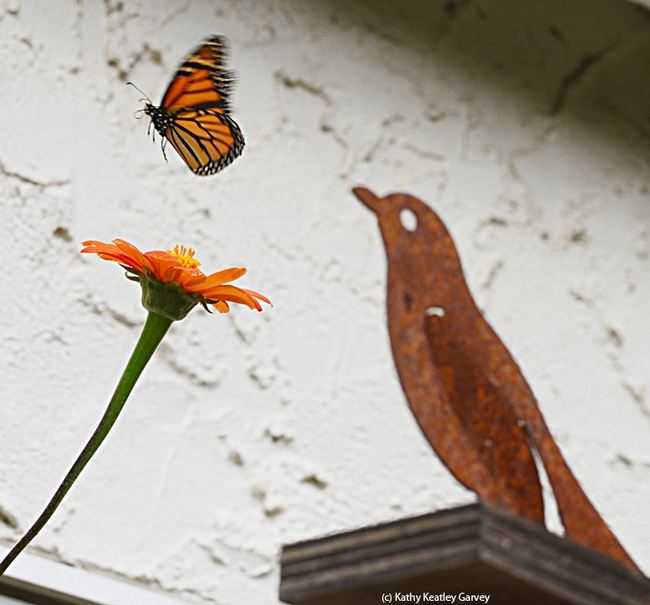
Up, up and away--but not because the bird was a threat. (Photo by Kathy Keatley Garvey)
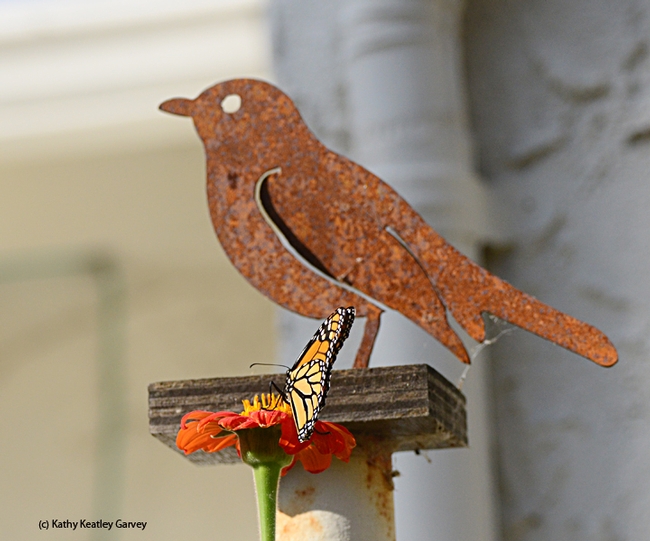
The monarch returns to the bird sighting, this time to sip nectar by its feet. (Photo by Kathy Keatley Garvey)
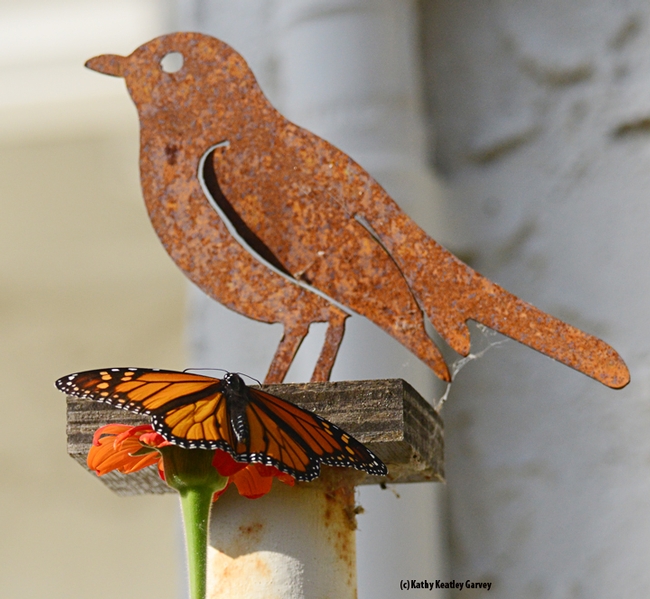
The monarch spreads its wings. The bird cannot. (Photo by Kathy Keatley Garvey)
What You May Not Know About Hummingbirds
Pollinators aren't just bees, butterflies, beetles and bats. They're also birds, like...
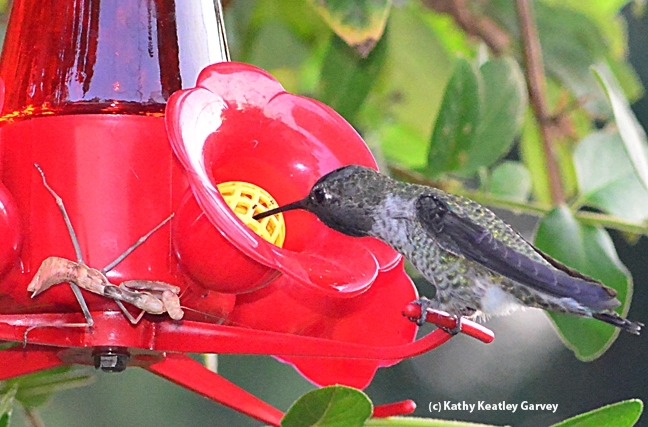
Hummingbirds eat insects and insects eat hummingbirds. Here a praying mantis lurks by a hummingbird feeder. It was quickly removed to another spot. (Photo by Kathy Keatley Garvey)
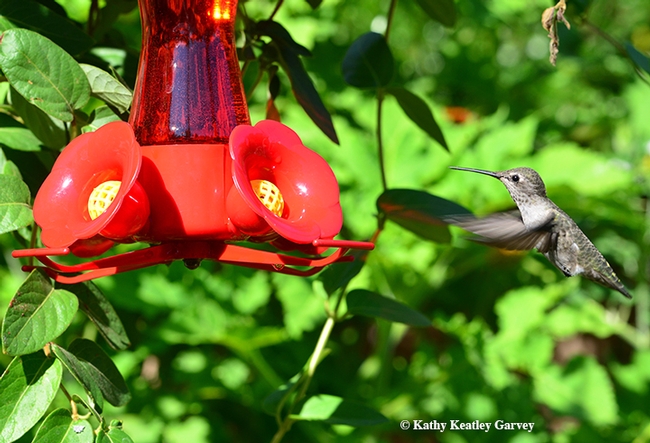
A hummingbird flies in for a quick burst of energy. It is best not to use red dye in a feeder; some companies make hummingbird feeders with red glass. (Photo by Kathy Keatley Garvey)
It's a Bird! It's a Plane! No, It's...
It's a bird! It's a plane! Is it Superman? No, it's a bird dropping. If you're growing sweet...
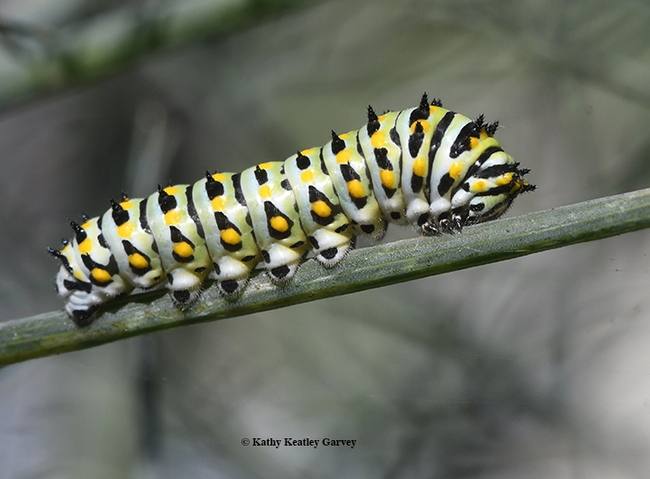
The iconic anise swallowtail caterpillar is a pale green with black bands containing orange spots. This is probably the fifth instar. (Photo by Kathy Keatley Garvey)
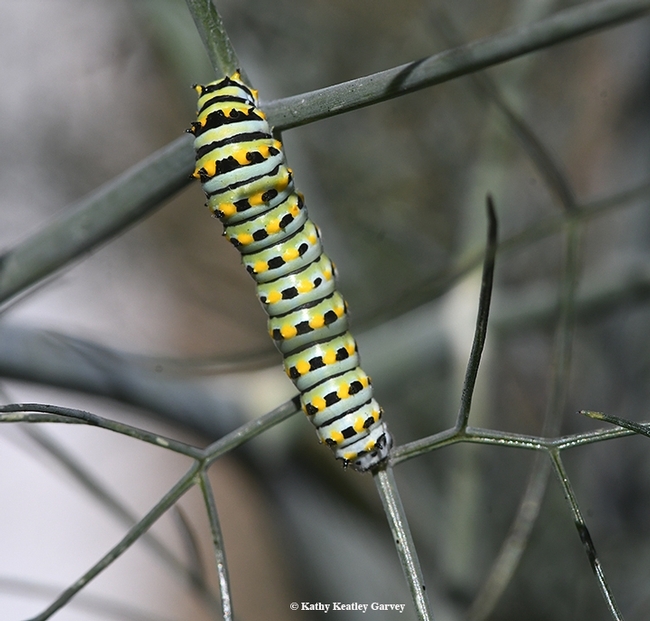
Dorsal view of an anise swallowtail caterpillar. (Photo by Kathy Keatley Garvey)
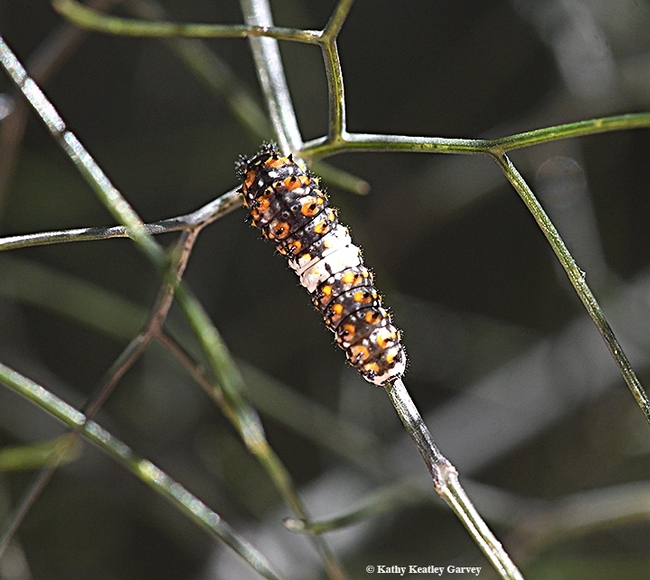
This younger larva of the anise swallowtail resembles a bird dropping. (Photo by Kathy Keatley Garvey)
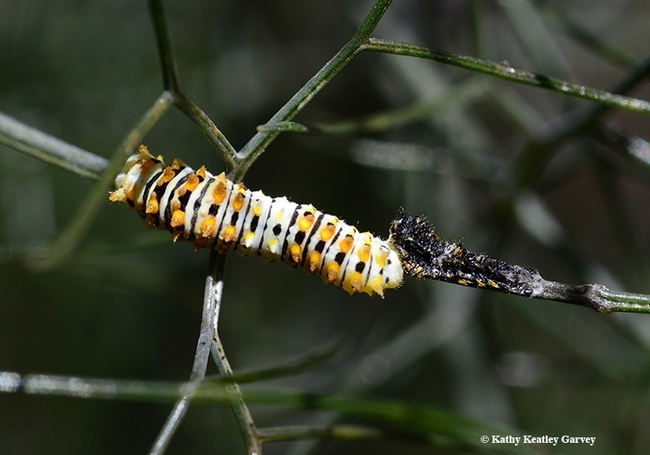
This anise swallowtail caterpillar is shedding its skin or molting, leaving its “bird dropping” skin behind. This is probably the third instar. (Photo by Kathy Keatley Garvey)
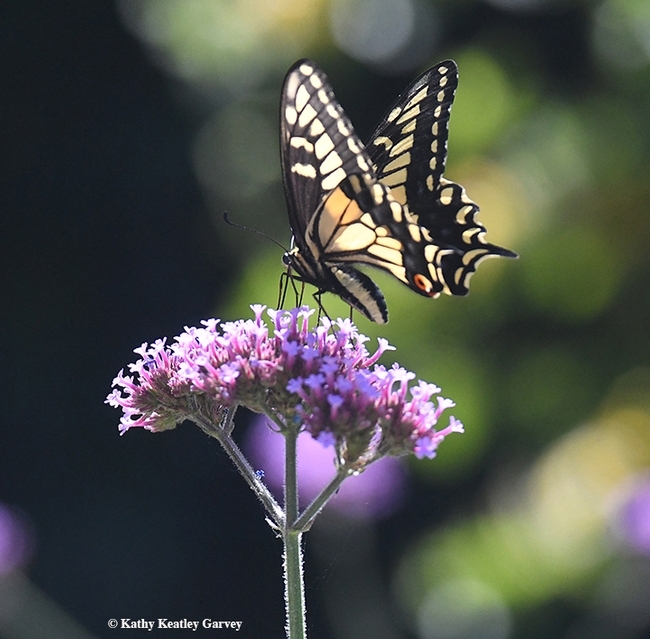
An adult anise swallowtail nectaring on Verbena. (Photo by Kathy Keatley Garvey)

